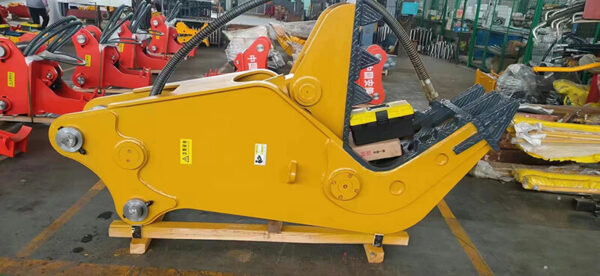9 Types of Excavator Attachments

Types of excavator attachments
Excavators owe their versatility to the different kinds of attachments that are available to them. Attachments for excavators are broken down into different types based on how the excavator is used. The below table gives a quick overview of the attachments used in different application scenarios.
- Excavation Attachments – Excavation bucket (with many variants)
- Demolition Attachments: Hydraulic Hammer, Shear, Pulverizer, Cold Planer
- Material Processing Attachments: Screen, Crusher
- Agriculture, Forestry, and Landscaping Attachments: Hydraulic Auger, Ripper, Trencher, Landscape Tiller, Brushcutter, Mulcher, and Wheel Saw
- Material Handling Attachments: Pallet Fork, Bale Grabs, Grapple
- Compaction Attachments: Vibratory Plate Compactor, Vibratory Wheel Compactor,
- Adapters: Tilting
Though these attachments have been classified into different types based on their application scenarios, many a time you will find a lot of cross usage of attachments. Read this article to knpw more.
Excavator Buckets
The bucket is the most basic and commonly used attachment for an excavator. In simple words, a bucket is a metal container that can carry material. Given the kind of jobs that excavators do, the regular excavator bucket attachments are usually heavy, rugged, and manufactured with high density metal alloys. All buckets are also packed with varying types of cutting edges, bucket teeth, and other accessories as needed for the job. Also, buckets are generally sized and shaped depending on the material handled and the kind of earthmoving task at hand.
Auger
An auger attachment for an excavator is a special tool that can be used to drill holes in the ground for things like fence posts, planting trees, building foundations, and taking samples of the soil. The attachment is typically made of heavy-duty steel and comes in a range of sizes and designs to suit different application scenarios.
Grapple Saw
A grapple saw attachment on an excavator is a powerful tool that combines the functions of a grapple and a chain saw into one unit. Most of the time, the attachment is a heavy-duty hydraulic grapple that has a saw blade on the end. The grapple lets the operator hold and move big things safely, and the saw blade lets them cut branches, trees, and other plants quickly and easily.
Shear
A shear attachment (also called as demolition shear or hydraulic shear) for an excavator is made to cut and remove metal objects like steel beams and pipes during demolition and construction projects. A shear attachment looks like a pair of curved scissors and plays a similar role, albeit cutting stronger materials like metal. The attachment is typically made of heavy-duty steel and comes in a range of sizes and designs to suit different applications and requirements. The excavator shear comes with replaceable cutting edges that are made of specialty grade steel.
The hydraulic system of the excavator powers the cutting arms or blades of the shear attachment, which lets the operator cut through the metal object with precision. The operator can control the speed and pressure of the cutting process, making it a precise and efficient tool for demolition.
Cold Planer
A cold planer is an attachment that works with an excavator and is used to mill or grind down asphalt or concrete surfaces. Most of the time, this part is attached to the arm of the excavator and is powered by the hydraulic system of the excavator. The cold planer consists of a rotating drum with carbide teeth that grinds down the surface of the pavement, creating a smooth, level surface. Cold planers are the right attachment for resurfacing projects where pavements or other surfaces are ground down and then covered with new pavement or other surface materials.
Trencher
According to Merriam-Webster’s dictionary, a “trench” is “a long cut in the ground.” Trenching, simply put, is the digging of a trench. Excavators come with a special attachment called the trencher for digging trenches. It is commonly used for laying pipes, cables, or other underground utilities.
The trencher attachment is typically made of heavy-duty steel and comes in a range of sizes and designs to suit different project requirements. The excavator’s hydraulic system is what powers the recent generation of trencher attachments.
Pulverizer
A pulverizer attachment for an excavator is a special tool made to break up concrete, rock, and other hard materials into smaller pieces that are easier to throw away or recycle. The pulverizer attachment uses the hydraulic power from the excavator to move a number of interlocking crushing jaws or plates. The pulverizer can also be used to crush concrete for easy removal after demolition. Because of this, these attachments are also called concrete crackers.
Mechanically, the pulverizer is made and operates the same way as the demolition shear, but it is usually bigger and has more crushing teeth or cutting edges. The pulverizer is optimized to destroy concrete, while the shear is not. Overall, the pulverizer retains all the advantages of a shear, including its speed and accuracy.
Mulcher
A mulcher is an excavator attachment that is utilized for the removal of vast quantities of trees, brush, and stumps. Like other attachments, the mulcher relies on the hydraulic system of the excavator for power. There are two types of mulchers, namely the drum mulcher and the disc mulcher, which operate differently mechanically.
Hydraulic Hammer
The hammer attachment, also known as the hydraulic breaker or rock breaker, is a powerful tool that is used for breaking up rocks, concrete, asphalt, and other hard materials. At its most basic level, a hydraulic hammer attachment works by using hydraulic pressure to deliver repeated blows to the material, breaking it apart into smaller pieces. The operator can control the force and frequency of the hammer blows, making it a precise and efficient tool for demolition and excavation work.
